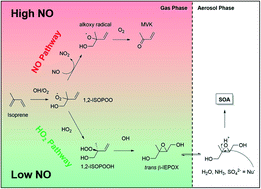Seasonality of isoprene emissions and oxidation products above the remote Amazon†
Abstract
The Amazon rainforest is the largest source of isoprene emissions to the atmosphere globally. Under low nitric oxide (NO) conditions (i.e. at NO mixing ratios less than about 40 pptv), isoprene reacts rapidly with hydroxyl (OH) to form isoprene-derived peroxy radicals (ISOPOO), which subsequently react with the hydroperoxyl radical (HO2) to form isoprene epoxydiols (IEPOX). IEPOX compounds are efficient precursors to the formation of secondary organic aerosols (SOA). Natural isoprene emissions, therefore, have the potential to influence cloudiness, rainfall, radiation balance and climate. Here, we present the first seasonal analysis of isoprene emissions and concentrations above the Amazon based on eddy covariance flux measurements made at a remote forest location. We reveal the forest to maintain a constant emission potential of isoprene throughout the year (6.9 mg m−2 h−1). The emission potential of isoprene is calculated by normalising the measured fluxes to a set of standard conditions (303 K and 1500 μmol m−2 s−1). During the wet season a factor of two reduction in absolute emissions was observed but this is explained entirely on the basis of meteorology and leaf area index, not by a change in isoprene emissions potential. Using an innovative analysis of the isoprene fluxes, in combination with measurements of its oxidation products and detailed chemical box-modelling, we explore whether concentrations of IEPOX follow the same seasonal cycle as the isoprene precursor. Our analysis implies that during the dry season (Sep–Jan) air pollution from regional biomass burning provides a modest increase in NO concentrations (indirectly inferred from a combination of other anthropogenic tracer measurements and box-modelling) which creates a competing oxidation pathway for ISOPOO; rather than forming IEPOX, alternative products are formed with less propensity to produce aerosol. This competition decreases IEPOX formation rates by a factor of two in the dry season compared with a scenario with no anthropogenic NO pollution, and by 30% throughout the year. The abundance of biogenic SOA precursors in the Amazon appears not to be dictated by the seasonality of natural isoprene emissions as previously thought, but is instead driven by regional anthropogenic pollution which modifies the atmospheric chemistry of isoprene.

- This article is part of the themed collections: Atmosphere – Biosphere Interactions – Topic Highlight and World Earth Day


 Please wait while we load your content...
Please wait while we load your content...